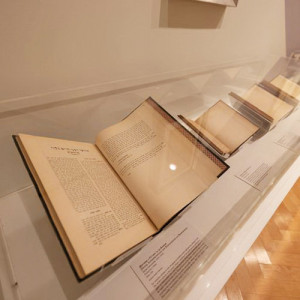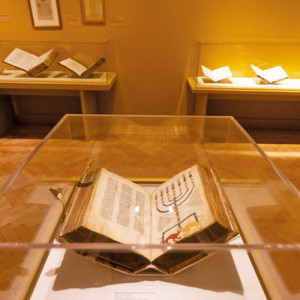
The landmark exhibit “The Golden Path: Maimonides Across Eight Centuries” is now on view at the Yeshiva University Museum in New York until December 31. It is a highly comprehensive collection showcasing the religious leadership and intellectual quest for truth of Moses Maimonides, 12th century rabbi, doctor and philosopher, who lived from 1138 to 1204. In the words of YU President Ari Berman, “Yeshiva University is honored to introduce the journey of Maimonides’ works to the broader community who through this exhibit can better develop their knowledge of Maimonides, Jewish history and the values on which to build their lives.”
Exhibition Guest Curator Dr. David Sclar, Teaneck resident and currently a librarian and history instructor at Yeshivat Frisch, developed his passion for Maimonides while working in the special collections of the Library of the Jewish Theological Seminary, which houses one of the largest extant collections of Maimonidean texts. Throughout his academic career at Princeton University, Harvard University, the University of Oxford, the University of Toronto and YU’s Bernard Revel Graduate School, Sclar researched and published work on the history of Jewish books, printing and libraries, as well as on Ramchal and Italian and Sephardic history.
The idea for this iconic exhibit was hatched when Sclar met Robert and Debbie Hartman of Chicago, the largest private collectors of Maimonidean manuscripts and rare books. “Arguably, no other individual has had a more pervasive or enduring effect on Jewish religious life over the last millennium than Maimonides,” said Sclar.

“The Golden Path” traces Maimonides, his journey and his thought, through a study of visual materials such as depictions of Maimonides, manuscripts and rare printed texts from collections around the world, exploring their varied historical, cultural and Maimonidean contexts. The exhibition is accompanied by a fully illustrated catalogue, co-published by Liverpool University Press, which explores Maimonides’ impact on the Mediterranean and Islamic cultures in which he lived. The catalogue also offers essays by noted scholars from institutions such as Princeton University, the University of Amsterdam, the University of Oxford, Bar-Ilan University, Ben Gurion University, Haifa University and Hebrew University of Jerusalem, as well as scholars from Yeshiva University, including Rabbi Dr. Ephraim Kanarfogel of Teaneck. The volume is available for purchase online from Oxford University Press or Amazon
The exhibit features items that have never been on public display. They include 13th-century Yemenite manuscripts, early printed books from Italy and the Ottoman Empire, and rare texts produced by and for Christian audiences from the Hartman collection. Spectacular manuscripts, some in Maimonides’ own hand, have been borrowed from collections around the world, including the Bodleian Libraries in Oxford, the British Library, the National Library of Israel, the Royal Library in Copenhagen and the Jewish Theological Seminary.
Notable among the pieces are a manuscript written by Sir Isaac Newton in which he cites Maimonides’ Laws of the New Moon in his proposal for reform of the Julian calendar. Included are fragments from the Cairo Genizah, one bearing the actual signature of Maimonides. Also on display is a volume of Maimonides’ “Commentary on the Mishnah” with hand-written notes by the sage himself, along with a well-known sketch of the Temple Menorah with straight arms, which in recent years has become the model for Chanukah Menorahs around the world. An illuminated manuscript of the monumental philosophical treatise “Moreh Nevuchim, Guide for the Perplexed,” completed in 1349 and held in a private collection for 500 years, is on public display for the first time, on loan from the Italian government.
In sharing the backstory of his impressive and expansive Maimonidean collection, Robert Hartman states in his preface to the catalogue: “During my late 30s and early 40s, I went through a period of analyzing my religious beliefs and devotion. Needing to bridge my past and the present, I searched for a way to synthesize my faith and logic. When presented by a rare book dealer in Lakewood, NJ, with a 15th-century Italian manuscript of ‘Moreh Nevuchim,’ I immediately identified with it. Seeing and holding a 500-year-old piece of Jewish history had a magnetic connection to my life as a child of Holocaust survivors and as a refugee from Hungary.

“This book had traveled a long way and survived countless and unknowable events. It was a testament to the Jewish people and our continuous survival. … The subsequent 20-year interval turned my hobby into a passion. … This path helped me develop a much fuller, richer spiritual life. … I spent wonderful times with my children and grandchildren exploring these rare books and witnessed the glow of awe and amazement on their faces in beholding something so old, so rare and so meaningful. … I lend my 40-year collection to this unique exhibit with a sense of gratitude and humility to Hashem.”
Said Sclar, the exhibition’s curator: “Arguably, no other individual has had a more pervasive or enduring effect on Jewish religious life over the last millennium. Maimonides’ written work, whether penned for the few (‘Moreh Nevukhim,’ medical treatises) or the many (“Commentary on the Mishneh Torah,” epistles), almost immediately attained near-canonical status and has perpetually spawned new audiences. His voice has sparked interest in assorted social and political circumstances, across diverse intellectual and cultural environments. Jews of Medieval Spain and Yemen, early modern Venice and Istanbul, modern Germany and Lithuania, and contemporary Israel and the United States, have regarded Maimonedes as the archetype of a common heritage.”
It is the hope that the exhibit will draw visitors of all backgrounds and all ages during its eight months in New York. To date, school groups from New Jersey including Yeshivat Frisch, Kushner Academy, TABC, Ma’ayanot and Flatbush Yeshiva High School have visited the exhibit with their instructors and have expressed awe at the beauty of these well-preserved texts and artifacts.
“The Golden Path: Maimonides Across Eight Centuries” is on display at the Yeshiva University Museum. located at 15 West 16th Street, New York City.

Hours of viewing: Monday-Wednesday, 10 a.m.-4 p.m.; Thursday, 10 a.m.-7:30 p.m.; Sunday, 10 a.m.-4 p.m. (Closed Friday and Saturday).
For group tours, call 212-294-8336.
Admission is free.










